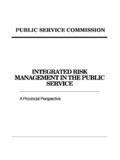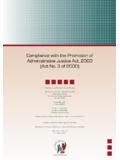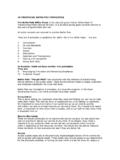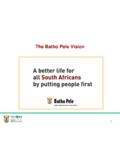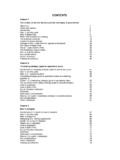Transcription of Report on the implementation of the Batho Pele …
1 Report on the implementation of the Batho Pele principle of Openness and Transparency in the Public ServicePublic Service CommissionFebruary 2008 VisionThe Public Service Commission is an independent and impartial body created by the Constitution, 1996, to enhance excellence in governance within the Public Service by promoting a professional and ethical environment and adding value to a public administration that is accountable, equitable, effi cient, effective, corruption-free and responsive to the needs of the people of South Public Service Commission aims to promote the constitutionally enshrined democratic principles and values of the Public Service by investigating, monitoring, evaluating, communicating and reporting on public administration. Through research processes, it will ensure the promotion of excellence in governance and the delivery of affordable and sustainable quality on the implementation of the Batho Pele principle of Openness and Transparency in the Public ServiceFebruary 2008 Published in the Republic of South Africa by:THE PUBLIC SERVICE COMMISSION (PSC)Commission Housecnr Hamilton & Ziervogel StreetsArcadia, 0083 Private Bag x121 Pretoria, 0001 Tel (012) 352-1000 Fax (012) 325-8382 Website Anti-Corruption Hotline Number: 0800 701 701 (Toll-Free)Compiled by: Branch: Investigations Human Resource ReviewsDistribution by: Directorate: Communication and Information ServicesPrinted by: The Kashan GroupISBN: 978-0-621-37642-5RP.
2 23/2008iiiIVVVIVII12235 ForewordPrior to 1994, the apartheid-led government suppressed access to information in an effort to stifl e opposition to its racial supremacy. Progressive groups came to see unrestricted access to information as a cornerstone of transparent, participatory and accountable governance. With the advent of democracy, government emphasized the importance of transparency and sharing of public information. This was refl ected in the South African Constitution which stipulates that transparency must be fostered by providing the public with timely, accessible and accurate information. Supporting this Constitutional value, the White Paper on the Transformation of Public Service Delivery ( Batho Pele), that was published in 1997, requires that citizens [must] be told how national and provincial departments are run, how much they cost and who is in charge.
3 Since the introduction of this White Paper, government departments have done much to address the demands of citizens, but have also been faced with a number of challenges in expanding service delivery and often within an environment of human resource and other part of its mandate the Public Service Commission (PSC) has been monitoring the progress made by the departments towards the implementation of the White Paper. In terms of this mandate, the PSC began evaluating the implementation of Batho Pele in 2000 by undertaking research into compliance with the Batho Pele framework. This was followed by a series of studies from 2005 to 2007 evaluating the performance and compliance of national and provincial government departments with the Batho Pele principles. This is the sixth study in that series, and it evaluates progress departments have made in implementing the Constitutional principle of Openness and Transparency.
4 I trust that this Report will draw attention to the Public Service s progress and challenges regarding the principle of Openness and Transparency and inform efforts to improve implementation . Citizens can only actively play meaningful roles in the departments programmes if they are well-informed. PROFESSOR SS SANGWENICHAIRPERSON iiiiiFOREWORD LIST OF FIGURES AND TABLESACRONYMSEXECUTIVE SUMMARYCHAPTER 1: INTRODUCTION Background to the study Aims of the study Structure of the reportCHAPTER 2: CONTEXTUAL BACKGROUND Introduction The Batho Pele principles? Openness and Transparency Legislative context Chapter 2 of the Constitution on the Bill of Rights The Promotion of Access to Information Act The Promotion of Administrative Justice Act Overview of PSC studies related to Openness and TransparencyCHAPTER 3: METHODOLOGY Introduction Data collection instrument Data analysis Limitations of the studyContentsiivvivii1233455677888101111 1113iiiCHAPTER 4.
5 FINDINGS OF THE STUDY Introduction Key fi ndings Findings on the First Phase Findings on the Second Phase Understanding of the Batho Pele principle of Openness and Transparency Mechanisms for promoting Openness and Transparency Development of standards and procedures for implementing Openness and Transparency Allocating responsibility and budget for implementing Openness and Transparency Monitoring and evaluation of Openness and Transparency Barriers in the implementation of Openness and Transparency Departments that have provided training Senior management support Self ratingCHAPTER 5: CONCLUSION AND RECOMMENDATIONS Introduction Conclusion Recommendations Openness and Transparency specifi c training should be provided The Annual Report to Citizens Development of targets or standards for Openness and Transparency Monitoring and evaluationANNEXURE A: MODEL ANNUAL Report TO CITIZENSANNEXURE B: QUESTIONNAIRE141515151616161819202021222 224252526262627272830ivList of figures and tablesList of figuresFigure 1: Availability of Annual Reports to Citizens Figure 2: Training on Openness and Transparency provided Figure 3: Self-rating by departments List of tablesTable 1.
6 Departments included in the study indicating compliance with the requirement of the Batho Pele White Paperv17212212 AcronymsAG Auditor-GeneralDPSA Department of Public Service and AdministrationHoD Head of DepartmentMEC Member of Executive CouncilNACH National Anti-Corruption HotlineNGO Non-Government OrganisationPDA Protected Disclosures ActPSC Public Service CommissionPAJA Promotion of Administrative Justice ActPAIA Promotion of Access to Information ActPFMA Public Finance Management ActSAHRC South African Human Rights CommissionSAPS South African Police ServiceSDIP Service Delivery Improvement PlanviviiviiExecutive Summary1. Background to the studyDuring the apartheid era, South Africa s minority government suppressed access to information on social, economic and security matters, in an effort to stifl e opposition of its policies of racial supremacy.
7 Access to information became a critical source for progressive groups in their efforts to promote transparent, participatory and accountable governance. Ultimately, with the advent of democracy in 1994, the new democratic government emphasized the importance of the fl ow of accurate and reliable information to the citizens to ensure their meaningful participation in requirement for transparency was ultimately captured in South Africa s Constitution1 which provides among others, that public administration must be guided by the principles of Openness and Transparency. Specifi cally, the Constitution states that, transparency must be fostered by providing the public with timely, accessible and accurate information. The White Paper on the Transformation of Public Service Delivery ( Batho Pele) further requires that Citizens be told how national and provincial departments are run, how much they cost and who is in charge.
8 Given this background, the Public Service Commission (PSC) embarked on a study to assess the progress departments have made in implementing this Constitutional and Batho Pele principle of Openness and Transparency. 2. ScopeThe scope of the study was both national and provincial governments. All 138 departments from these two spheres of government were included in the study with the exception of the following departments: National Intelligence Agency; The South African Secret Service; and The South African Defence MethodologyData collection was done in three phases. During phase one, the PSC sent letters to all Heads of Department (HoDs) of national and provincial departments asking them if they compile and distribute Annual Reports to Citizens as required by the Batho Pele White Paper, and to submit copies of these reports.
9 Seventy nine departments responded during the fi rst phase of the phase two, a sample of departments that had and those that did not distribute Annual Reports to Citizens was drawn. The sample comprised 31 provincial and two national departments. Interviews were conducted with designated offi cials in these departments using a questionnaire. 1 Republic of South Africa, The Constitution of the Republic of South Africa. Act108 of the third phase a selection of critical documents was reviewed. Documents such as the Annual Reports to Citizens, the Annual Reports and departmental documents provided by departments in the interviews were included in the document review. Batho Pele related documents such as the White Paper and the Hand Book as well as previous reports of the PSC were also reviewed.
10 4. FindingsThe following are the main fi ndings of the Findings on the First PhaseThe Batho Pele White Paper requires that departments publish Annual Report to Citizens as part of implementing the principle of Openness and Transparency. Of the 138 Public Service departments who were initially requested to provide information on the publication of the Annual Report to Citizens, 18 provincial departments were found to comply with this requirement whereas 84 provincial departments did not. No national department was found to have complied with this requirement. All the departments in the Limpopo province complied. Only two of the departments in the Free State did not comply. However, all the departments that did not comply with the above mentioned requirement did implement other mechanisms such as annual Report , brochures, izimbizo and Service Delivery Improvement Plans (SDIPs) to provide information to citizens.


